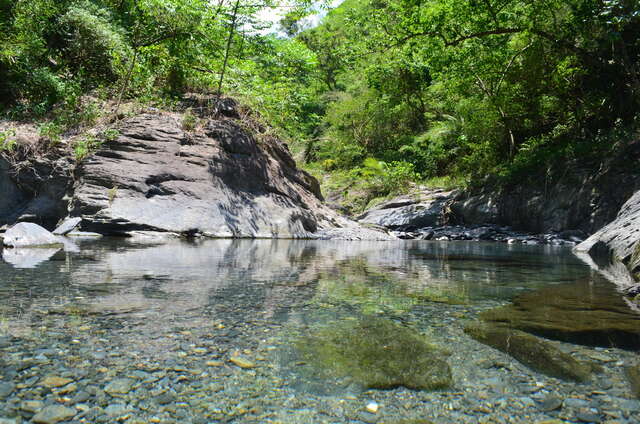Maolin National Scenic Area Introduction
Maolin Valley is located at the confluence of the Zhuokou River and its tributary, the Musheng River, on the eastern side of Maolin Village. Originally named "Romus," which means "beautiful valley" in the Rukai language, the valley features the deep blue and serene waters of a stunning pool formed by the meandering Zhuokou River and Musheng River. The Maolin Waterfall cascades spectacularly, but the bottom of the blue pool has a whirlpool, which locals jokingly call the "Maiden's Trap," making it unsuitable for swimming or playing in the water. Visitors can enjoy the magnificent natural scenery from an elegantly designed pavilion near the waterfall. The three famous mountains of Maolin—Longtoushan, Shetoushan, and Guixingshan—are connected by the Zhuokou River, which, along with the high mountain landscapes, creates waterfalls, gorges, and rich biodiversity, as well as unique terrains and geological features. Longtoushan and Shetoushan are examples of kettle hole topography. The forms of Shetoushan and Longtoushan are different; Shetoushan is connected to the hills behind it through the accumulation of soil and rocks, resembling a snake's head, while Longtoushan exists on either side in a complementary manner. The current separation of Longtoushan's head from its ridge resulted from deliberate blasting during the Japanese colonial period to facilitate local transportation by altering water flow. This natural wonder, resembling a dragon spitting pearls, is the result of the meandering and kettle hole topography. Viewed from above, it appears as a giant dragon coiled in the valley, creating a breathtaking sight. Longtoushan, Shetoushan, and Guixingshan are collectively known as the three famous mountains of Maolin. Old Maolin Ruins are located above Meiya Creek and Meiya Waterfall in Wanshan Village of Maolin District, situated on a 45-degree slope at an altitude of 500 to 600 meters. According to local legends and stories, the site dates back quite early, but specific founding dates are difficult to ascertain. In 1940, due to Japanese administrative policies, residents of Old Maolin were relocated to the present site of Maolin Village, leading to the abandonment of the old site. Remains of 65 identifiable stone houses can still be found at the site, with complete structures and layouts. The stones used in construction are local black-gray slate and shale, which were simply processed into regular-shaped slates to build square houses featuring distinct Rukai characteristics. Although the roofs have collapsed, and only walls or foundations remain, the collective sight of the stone house ruins is still quite impressive. Above the northwest side of the settlement site, remnants of a police station and indigenous educational facility established by the Japanese colonial government are still preserved. The Old Maolin site not only reflects the community's life but also presents the actual environment of Japanese indigenous policies, making it a valuable heritage. The Purple Butterfly Valley is primarily located in Maolin, Kaohsiung. From November to March of the following year, it is estimated that at least over a million purple butterflies with wings resembling gliders migrate to the warm, sheltered valleys at the foot of Mount Dawu, a sacred mountain for the Rukai and Paiwan people in southern Taiwan, forming a wintering group that can reach over a million butterflies. The butterfly-viewing boardwalk is located behind the district office, where the morning during the wintering season is the best time to observe their graceful dance along the trail. Qingren Valley, located near the entrance of the Maolin National Scenic Area, was once a favorite spot for tourists but is currently under reconstruction due to storm damage. Situated on the tributary of the Zhuokou River in the southern part of Maolin District, Qingren Valley, or "Tubalu" in the Rukai language, is famous for its natural landscapes, including gorges, hot springs (currently closed), and streams. The Qingren Valley Waterfall group, which consists of five tiers from top to bottom, is particularly stunning. Due to the dense trees, visitors can only reach the second tier via a side staircase, where the cascading white water creates a magnificent display, and the refreshing water droplets touch the face in the breeze, bringing comfort and ease. In this harmonious landscape of mountains and rivers, one can reflect gently on a moving love story that leaves an everlasting memory.



























